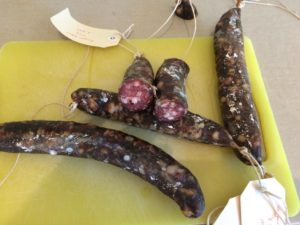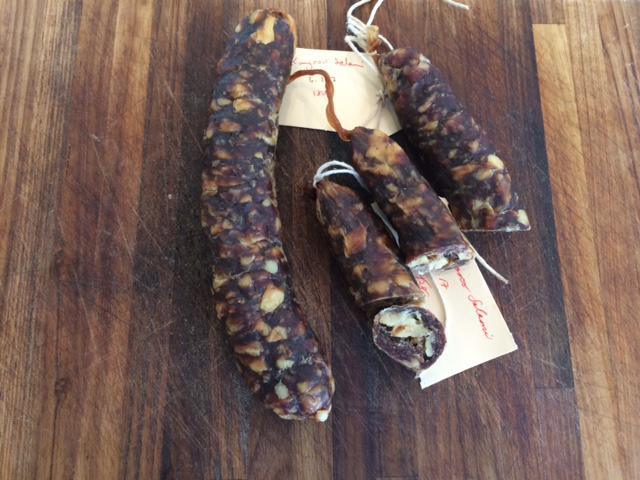Murray rang me to say that he had shot a kangaroo. Well, a few kangaroos actually. I do not know what the kangaroos did to serve that. However, Murray used to be a cop so I guess he needs no encouragement nor excuse. As long as they weren’t shooting back, that was all that mattered.
Murray wanted to make sausages. We had done this before, although that is another story. But I digress. It seemed to me that sausages were just the start. There were many options available. I thought that we could make sausages, salami and bresaola. It was very clear to me it would be a tour de force. I had written A Charcuterie Diary, I was a Master of the Kitchen. All would be good, all would be successful.
Murray arrived early. He had quite a lot of skippy, about 5kgs. I had everything ready. I had researched the issue. Needless to say one does not come across skippy sausages or skippy salami recipes. Adapt, improvise, overcome. I found venison sausage recipes. They seemed like they might work. They were based on a mix of venison meat, very lean, and pork mince. The ratio was 70 : 30. Such a ratio it seemed to me would work for skippy sausages. As for salami I considered that the addition of say 10{979a7306d48fe103a197c5b885d46af8051ba0faf64215e28a1c21a89e6907c0} back fat would probably do it. Naturally salt at 3{979a7306d48fe103a197c5b885d46af8051ba0faf64215e28a1c21a89e6907c0} and Curing Salt No. 2 at 0.3{979a7306d48fe103a197c5b885d46af8051ba0faf64215e28a1c21a89e6907c0} would be required. We minced the kangaroo. We minced the pork shoulder. We diced the back fat. I had some minced pork belly in reserve. Just in case.
As with these things I calculated the amounts of dry ingredients that I would need. These were based upon the venison sausage recipe but converted from imperial to metric. Such are the problems in this area. I used my salt and Curing Salt percentages. It all took quite a while. I took shoes and socks off to calculate the maths, in the end I just had to use a calculator. At all events everything was prepared. We added the meat and dry ingredients. It took quite a long time.
We did the convention fry off of a small piece of mix. It was very strong tasting. Too strong. We started modifying the recipe. We added extra pork belly and other dry ingredients. We mixed. We tasted. We mixed some more. We fried off samples. We formed a tasting panel, No. 1 Son and Harold. They agreed on a mix (finally), so did we.
We did not alter the basic amount of salt and Curing Salt. I knew that I should have, but I thought that there was enough leeway in both to be ok. That was a mistake, but I did not know it at the time. We were off the reservation and there was no going back. We stuffed it into casings. We tied them off. We cut them into individual links. I hung them for 48 hours to ferment. It all looked good. They were individually weighed and labels prepared. All was still good. They were hung in the curing chamber until they lost 30{979a7306d48fe103a197c5b885d46af8051ba0faf64215e28a1c21a89e6907c0} of their weight. They were still a bit soft so I left them for a while longer. They were good. They looked good. They were hard and dry.
I tested some by cutting at about 30{979a7306d48fe103a197c5b885d46af8051ba0faf64215e28a1c21a89e6907c0} weight loss. They were a bit soft but had a good colour inside. Things were OK. At all events, after about 3 months, I tried some. They looked really good (on the outside). Inside they were a brownish colour. The fat was a bit yellowish. They did not taste or smell very good at all, but were not rotten. A taste confirmed it, an overwhelming flavour of rancid fat.
My only conclusion is this – by going off the reservation the percentage of fat and Curing Salt were reduced such that the product was unusable for long term storage. Ironically, I think now, after about 30{979a7306d48fe103a197c5b885d46af8051ba0faf64215e28a1c21a89e6907c0} weight loss, they would have been OK. They would not have kept for very long (as indeed they did not) but for a short term product they would have been OK.
Moral of the story? Never trust an ex-cop with a load of dead kangaroos.
After a few weeks – exterior, note nice colour and dry appearance. Interior, note nice red colour.

After a 3 months – interior, note yellow fat but they look good on the outside.

The salami needs to dry and ferment for 48 hours. This is a nervous time. It is hanging over the laundry sink. A good temperature and humidity. They lose a bit of moisture so a plate underneath or over the sink is a good idea. Note how dark they are even at this stage kangaroo is a naturally dark meat. The process only makes it go darker.


